Skip to content 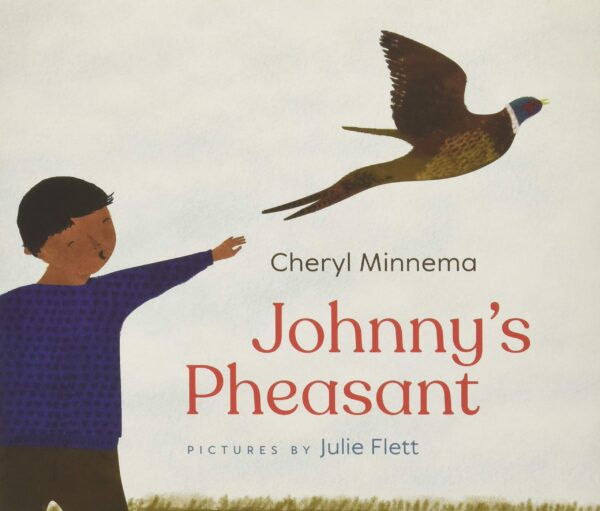
CHARLOTTE ZOLOTOW AWARD
The Charlotte Zolotow Award is awarded each year to a picture book published in America that shows excellence in text.
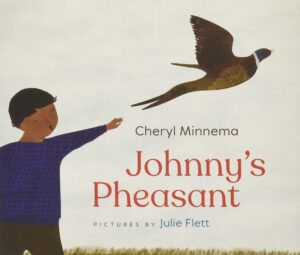
2020
Johnny’s Pheasant
By Cheryl Minnema
“Pull over, Grandma! Hurry!” Johnny says. Grandma does, and Johnny runs to show her what he spotted near the ditch: a sleeping pheasant. What Grandma sees is a small feathery hump. When Johnny wants to take it home, Grandma tries to tell him that the pheasant might have been hit by a car. But maybe she could use the feathers for her craftwork? So home with Grandma and Johnny the pheasant goes . . .
It’s hard to say who is most surprised by what happens next—Grandma, Johnny, or the pheasant. But no one will be more delighted than the reader at this lesson about patience and kindness and respect for nature, imparted by Grandma’s gentle humor, Johnny’s happy hooting, and all the quiet wisdom found in Cheryl Minnema’s stories of Native life and Julie Flett’s remarkably evocative and beautiful illustrations.
2019
Little Brown
By Marla Frazee
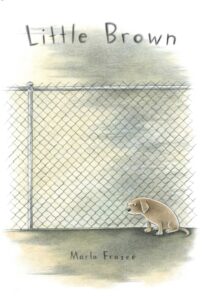
Little Brown is one cranky canine because no one ever plays with him at the animal shelter. Or maybe no one ever plays with him because he is cranky. Either way, Little Brown decides today is the day to take action, so he takes all of the toys and sticks and blankets from all of the dogs at the shelter and won’t give them back. But what will happen now?
2018
A Different Pond
By Bao Phi
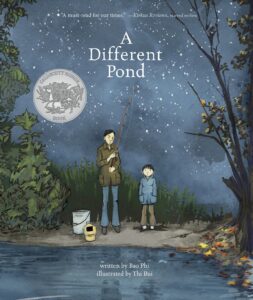
A Different Pond is an unforgettable story about a simple event – a long-ago fishing trip. Graphic novelist Thi Bui and acclaimed poet Bao Phi deliver a powerful, honest glimpse into a relationship between father and son – and between cultures, old and new. As a young boy, Bao and his father awoke early, hours before his father’s long workday began, to fish on the shores of a small pond in Minneapolis. Unlike many other anglers, Bao and his father fished for food, not recreation. A successful catch meant a fed family. Between hope-filled casts, Bao’s father told him about a different pond in their homeland of Vietnam. Thi Bui’s striking, evocative art paired with Phi’s expertly crafted prose has earned this powerful picture books six starred reviews and numerous awards.
2017
Freedom in Congo Square
By Carole Boston Weatherford
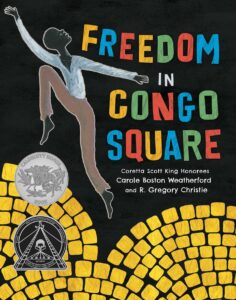
This poetic, nonfiction story about a little-known piece of African American history captures a human’s capacity to find hope and joy in difficult circumstances and demonstrates how New Orleans’ Congo Square was truly freedom’s heart.
Mondays, there were hogs to slop,
mules to train, and logs to chop.
Slavery was no ways fair.
Six more days to Congo Square.
As slaves relentlessly toiled in an unjust system in 19th century Louisiana, they all counted down the days until Sunday, when at least for half a day they were briefly able to congregate in Congo Square in New Orleans. Here they were free to set up an open market, sing, dance, and play music. They were free to forget their cares, their struggles, and their oppression.
This story chronicles slaves’ duties each day, from chopping logs on Mondays to baking bread on Wednesdays to plucking hens on Saturday, and builds to the freedom of Sundays and the special experience of an afternoon spent in Congo Square. This book includes a forward from Freddi Williams Evans (freddievans.com), a historian and Congo Square expert, as well as a glossary of terms with pronunciations and definitions.
2016
Drum Dream Girl: How One Girl’s Courage Changed Music
By Margarita Engle
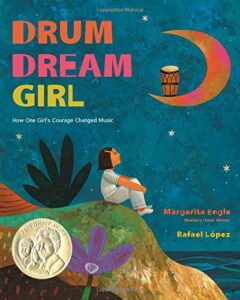
Girls cannot be drummers. Long ago on an island filled with music, no one questioned that rule—until the drum dream girl. In her city of drumbeats, she dreamed of pounding tall congas and tapping small bongós. She had to keep quiet. She had to practice in secret. But when at last her dream-bright music was heard, everyone sang and danced and decided that both girls and boys should be free to drum and dream.
Inspired by the childhood of Millo Castro Zaldarriaga, a Chinese-African-Cuban girl who broke Cuba’s traditional taboo against female drummers, Drum Dream Girl tells an inspiring true story for dreamers everywhere.
2015
Sparky
By Jenny Offill

The ingenious author of 17 Things I’m Not Allowed to Do Anymore and a brilliant illustrator and production designer of the Coraline movie have created a hilarious, touching picture book perfect for young animal lovers. Like the Caldecott Medal-winning Officer Buckle and Gloria, Sparky stars a pet who has more to offer than meets the eye. When our narrator orders a sloth through the mail, the creature that arrives isn’t good at tricks or hide-and-seek . . . or much of anything. Still, there’s something about Sparky that is irresistible.
2014
The Dark
By Lemony Snicket
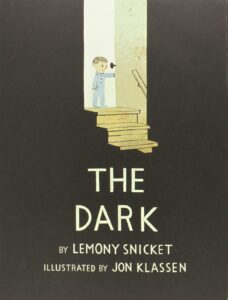
Laszlo is afraid of the dark.
The dark lives in the same house as Laszlo. Mostly, though, the dark stays in the basement and doesn’t come into Lazslo’s room. But one night, it does.
This is the story of how Laszlo stops being afraid of the dark.
With emotional insight and poetic economy, two award-winning talents team up to conquer a universal childhood fear.
2013
Each Kindness
By Jacqueline Woodson
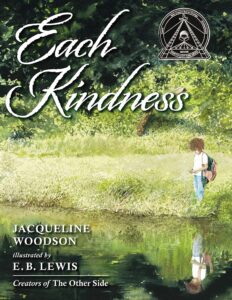
Chloe and her friends won’t play with the new girl, Maya. Every time Maya tries to join Chloe and her friends, they reject her. Eventually Maya stops coming to school. When Chloe’s teacher gives a lesson about how even small acts of kindness can change the world, Chloe is stung by the lost opportunity for friendship, and thinks about how much better it could have been if she’d shown a little kindness toward Maya.
2012
Me…Jane
By Patrick McDonnell

In his characteristic heartwarming style, Patrick McDonnell tells the story of the young Jane Goodall and her special childhood toy chimpanzee named Jubilee. As the young Jane observes the natural world around her with wonder, she dreams of “a life living with and helping all animals,” until one day she finds that her dream has come true. With anecdotes taken directly from Jane Goodall’s autobiography, McDonnell makes this very true story accessible for the very young–and young at heart.
One of the world’s most inspiring women, Dr. Jane Goodall is a renowned humanitarian, conservationist, animal activist, environmentalist, and United Nations Messenger of Peace. In 1977 she founded the Jane Goodall Institute (JGI), a global nonprofit organization that empowers people to make a difference for all living things.
The book descriptions used are primarily from the publishers.
If you like this post, then please consider sharing it and/or leaving a comment below. Thank you! Barbara Lowell, Children’s Author
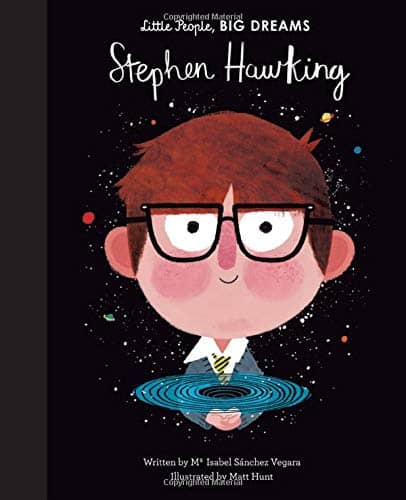
Stephen Hawking
By Maria Isabel Sanchez Vegara
When Stephen Hawking was a little boy, he used to stare up at the stars and wonder about the universe. Although he was never top of the class, his curiosity took him to the best universities in England, Oxford and Cambridge. It also led him to make one of the biggest scientific discoveries of the 20th century, Hawking radiation. This book features stylish and quirky illustrations and extra facts at the back, including a biographical timeline with historical photos and a detailed profile of the brilliant physicist’s life. 4-7 years

Stay Curious: A Brief History of Stephen Hawking
By Kathleen Krull, Illustrated by Paul Brewer
As a young boy, Stephen Hawking loved to read, stargaze, and figure out how things worked. He looked at the world and always asked, Why?
He never lost that curiosity, which led him to make groundbreaking discoveries about the universe as a young man. Even being diagnosed with ALS didn’t slow Stephen down. Those questions kept coming. As his body weakened, Stephen’s mind expanded allowing him to unlock secrets of the universe and become one of the most famous scientists of all time.
Stephen always approached life with courage, a sense of humor, and endless curiosity. His story will encourage readers to look at the world around them with new eyes. 4-8 years
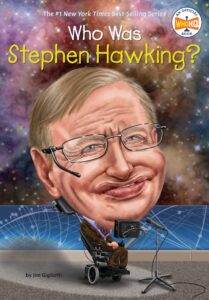
Who Was Stephen Hawking?
By Jim Gigliotti, Illustrated by Gregory Copeland
Stephen Hawking was born exactly three hundred years after the death of the scientist Galileo, so maybe it was written in the stars that he would become a famous scientist in his own right. Although he was diagnosed with a neurological disease at age 21, Stephen did not let the illness define his life.
Known for his groundbreaking work in physics, and identified by his wheelchair and computerized voice system, Stephen continued his research until his death in 2018. He is best known for his black hole theories and his best-selling book A Brief History of Time. Stephen Hawking is an example of a person who had a great mind, but an even greater spirit. 8-12 years
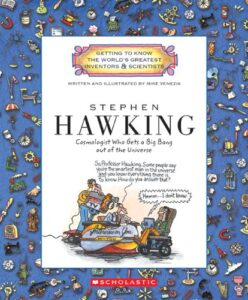
Stephen Hawking: Cosmologist Who Gets a Big Bang Out of the Universe
By Mike Venezia
Meet renowned physicist Stephen Hawking. This book presents the life and work of the British physicist who overcame the challenges of ALS to become one of the foremost scientists of the twentieth century.
This book combines a mix of historical reproductions, photos, and cartoon-style illustrations that bring to life Stephen Hawking’s work and contributions. 6-10 years

All About Stephen Hawking
By Chris Edwards, Illustrated by Amber Calderon
As an Oxford student, Stephen Hawking never expected that people across the world would know his name, or that his hobby of stargazing would lead him to be one of the world’s greatest scientists. Stephen Hawking made cosmology, or the study of the universe, accessible to everyone.
He was diagnosed with amyotrophic lateral sclerosis (ALS) at the age of twenty-one, but didn’t let that stop him from receiving a graduate degree from Cambridge and going on to be an expert in the scientific origin of the universe and black holes. Hawking is best known for writing A Brief History of Time, which explained cosmology in non-scientific terms so that non-scientists could understand it. 10-12 years
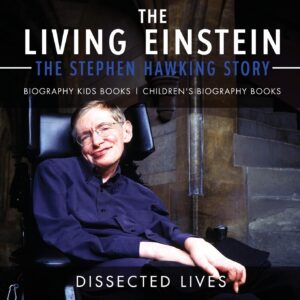
The Living Einstein: The Stephen Hawking Story
By Dissected Lives
Despite his debilitating illness, Stephen Hawking found ways to share his knowledge of the universe. He was a bright man who was always hungry for knowledge. He experimented, studied and explored anything and everything from the physical world to the cosmos. Be inspired by his story. Learn from his discoveries. 8-12 years
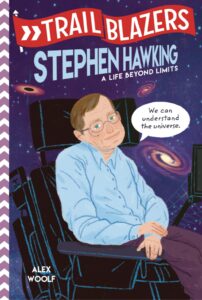
Stephen Hawking: A Life Beyond Limits
By Alex Woolf
In 1974, Stephen Hawking shook the world of physics. His theory on black holes went against everything the science community accepted as fact. How did he make such revolutionary discoveries? From a childhood spent building model airplanes to recognition as one of the greatest scientists of his time, Stephen’s genius and endless curiosity powered his work. Find out how this boy who loved science became one of history’s greatest trailblazers! 8-13 years
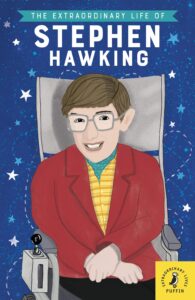
The Extraordinary Life of Stephen Hawking
By Kate Scott, Illustrating by Ester Mols
Stephen Hawking was: a physicist, a cosmologist, an author and one of the cleverest people who ever lived. While studying at Oxford University, Stephen Hawking was diagnosed with motor neurone disease, which meant that eventually he was completely paralyzed, and could only talk via a computer.
But that never held him back, and because of his work on time and space, he changed the way the world thinks about the universe.
Discover more about the life of a man who is known for his incredible contribution to science. 7-12 years
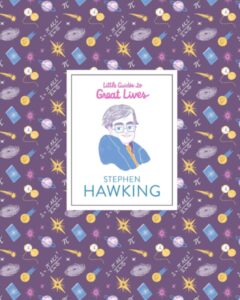
Little Guides to Great Lives: Stephen Hawkings
By Isabel Thomas, Illustrated by Marianna Madiz
Stephen Hawking was one of the world’s most renowned scientists and cosmologists. His ground–breaking research into black holes and the Big Bang has helped to explain the beginnings of our universe and his book A Brief History of Time has sold over 10 million copies. Diagnosed with a form of motor neuron disease when he was a young man, Stephen was inspired to achieve his goals as fast as possible. Through incredible determination and skill, he became a legendary scientist, a best–selling author, and the man that changed the way we think about the universe.
The book descriptions used are primarily from the publishers.
If you like this post, then please consider sharing it and/or leaving a comment below. Thank you! Barbara Lowell, Children’s Author
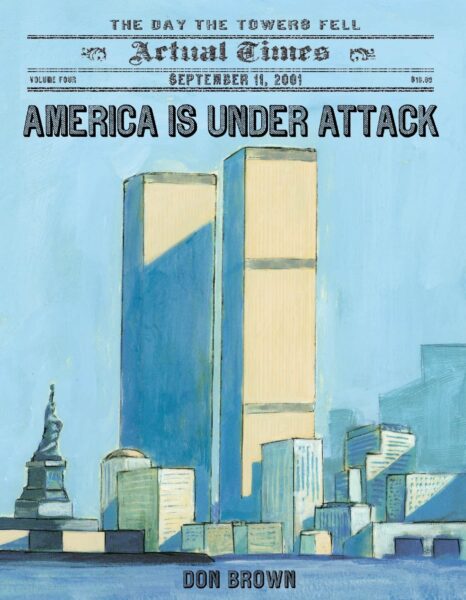
America is Under Attack: September 11, 2001 the Day the Towers Fell
By Don Brown
The events of September 11, 2001, changed the world forever. Don Brown narrates the events of the day in a way that is both accessible and understandable for young readers. Straightforward and honest, this account moves chronologically through the morning, from the terrorist plane hijackings to the crashes at the World Trade Center, the Pentagon, and in Pennsylvania; from the rescue operations at the WTC site in New York City to the collapse of the buildings. Watercolor illustrations capture the emotion and pathos of the tragedy making this an important book about an unforgettable day in American history. Grades 1-4

Survivor Tree
By Marcie Colleen, Illustrated by Aaron Becker
This hopeful story of a resilient tree that grew (and still grows) at the base of the twin towers is a simple introduction for young readers to gain an understanding of September 11th and the impact it had on America.
One September day, the perfect blue sky exploded. Dust billowed. Buildings crumbled. And underneath it all, a tree sprouted green leaves in its distress. Pulled from the wreckage, the tree saw many seasons pass as it slowly recovered far away from home. Until one day, forever scarred and forever stronger, it was replanted at the 9/11 Memorial.
This story of the real Survivor Tree uses nature’s cycle of colors to reflect on the hope and healing that come after a tragedy—and assures readers of their own remarkable resilience. 4-8 years
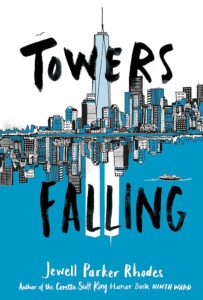
Towers Falling
By Jewell Parker Rhodes
When her fifth-grade teacher hints that a series of lessons about home and community will culminate with one big answer about two tall towers once visible outside their classroom window, Dèja can’t help but feel confused. She sets off on a journey of discovery, with new friends Ben and Sabeen by her side. But just as she gets closer to answering big questions about who she is, what America means, and how communities can grow and heal, she uncovers new questions. Like, why does Pop get so angry when she brings up anything about the towers?
Jewell Parker Rhodes tells a story about young people who weren’t alive to witness this defining moment in history, but begin to realize how much it colors their every day. Grades 3-7
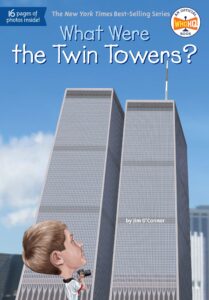
What Were the Twin Towers
By Jim O’Connor, Illustrated by Ted Hammond
Discover the true story of the Twin Towers—how they came to be the tallest buildings in the world and why they were destroyed.
When the Twin Towers were built in 1973, they were billed as an architectural wonder. At 1,368 feet, they clocked in as the tallest buildings in the world and changed the New York City skyline dramatically. Offices and corporations moved into the towers—also known as the World Trade Center—and the buildings were seen as the economic hub of the world. But on September 11, 2001, a terrorist attack toppled the towers and changed our nation forever. Discover the whole story of the Twin Towers—from their ambitious construction to their tragic end. Grades 3-7

National Geographic Readers: September 11
By Libby Romero
The events of September 11, 2001, changed the world forever. With photographs and sensitive, age-appropriate text, this Level 3 reader recounts the shocking attacks at the World Trade Center, the Pentagon, and in Pennsylvania. This book explains who was behind the attacks, and celebrates the spirit of hope that emerged through the inspiring story of rescue and recovery and the heroes who raced to save lives. 5-8 years

Fireboat: The Heroic Adventures of the John J. Harvey
By Maira Kalman
The John J. Harvey fireboat was the largest, fastest, shiniest fireboat of its time, but by 1995, the city didn’t need old fireboats anymore. So the Harvey retired, until a group of friends decided to save it from the scrap heap. Then, one sunny September day in 2001, something so horrible happened that the whole world shook. A call came from the fire department, asking if the Harvey could battle the roaring flames. In this true story, Maira Kalman brings a New York City icon to life and proves that old heroes never die. Preschool – 3rd Grade

The Survivor Tree: Inspired by a True Story
By Cheryl Somers Aubin, Illustrated by Shelia Harrington
The Survivor Tree: Inspired by a True Story takes the reader on a journey of hope and healing that parallels our nation’s own journey following the events of September 11, 2001.
A month after the collapse of the Twin Towers, workers on the site discovered a few green leaves showing through the gray concrete and ash. Clearing the debris, they found a badly injured Callery Pear Tree. She was rescued, taken to a nursery outside the city, and put in the care of Richie, a City Parks Worker. No one was sure if she would live. But the following spring, a dove built a nest in her branches and new green buds appeared.
Over the years, the tree, although still bearing scars, grew tall and strong. She is planted in a place of honor on the 9/11 Memorial Plaza and now known as “The 9/11 Survivor Tree.” This story describes the experience, memories, and feelings of the tree throughout her healing and her eventual return home. All profits from the sale of this book go to charity. 8-12 years

September 11 Then and Now
By Peter Benoit
Discover the events of September 11th, 2001, in one of the A True Book: Natural Disasters series. This book investigates the events leading up to the disaster, explores it causes, and ponders how the events changed, or could have altered history. 8-11years

Saved by the Boats: The Heroic Sea Evacuation of September 11
By Julie Gassman, Illustrated by Steve Moors
September 11, 2001, was a dark day in U.S. history. Amid the chaos, sea captains and crews raced by boat to the tragic Manhattan scene. Nearly 500,000 people on Manhattan Island were rescued that day in what would later be called the largest sea evacuation in history. In this story of heroism, we come to understand that in our darkest hours, people shine brightly as a beacon of hope. Grades 3-6
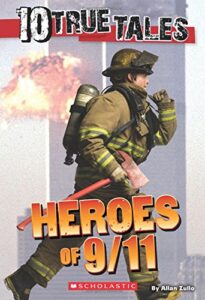
10 True Tales: Heroes of 9/11
By Allan Zallo
When Captain Jay Jonas of the Fire Department of New York hears an emergency radio message about the World Trade Center, he has no idea of the terrible conditions he and his team will face. Arriving at the burning building, the firefighters must summon all their courage. On the same morning, just outside Washington, D.C., a jetliner piloted by terrorists slams into the Pentagon. Can Colonel Philip McNair save lives inside the flaming building?
From the World Trade Center and the Pentagon to a hijacked plane above Pennsylvania, these ten stories of true American heroes on the day that changed America — September 11, 2001. Grades 3-7
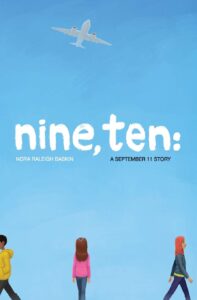
Nine, Ten: A September 11 Story
By Nora Raleigh Baskin
Ask anyone: September 11, 2001, was serene and lovely, a perfect day—until a plane struck the World Trade Center.
But right now it is a few days earlier, and four kids in different parts of the country are going about their lives. Sergio, who lives in Brooklyn, is struggling to come to terms with the absentee father he hates and the grandmother he loves. Will’s father is gone, too, killed in a car accident that has left the family reeling. Naheed has never before felt uncomfortable about being Muslim, but at her new school she’s getting funny looks because of the head scarf she wears. Aimee is starting a new school in a new city and missing her mom, who has to fly to New York on business.
These four don’t know one another, but their lives are about to intersect in ways they never could have imagined. Nora Raleigh Baskin weaves together their stories into a novel about that seemingly perfect September day—the day our world changed forever. Grades 3-7
The books descriptions used are primarily from the publishers.
If you like this post, then please consider sharing it and/or leaving a comment below. Thank you! Barbara Lowell, Children’s Author
To Learn More Visit the National September 11 Memorial and Museum https://www.911memorial.org/
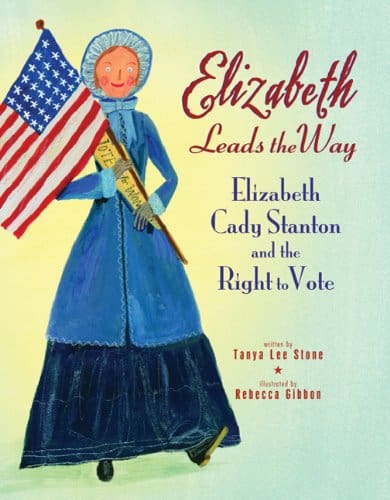
Elizabeth Leads the Way: Elizabeth Cady Stanton and the Right to Vote
By Tanya Lee Stone, Illustrated by Rebecca Gibbon
Elizabeth Cady Stanton stood up and fought for what she believed in. From an early age, she knew that women were not given rights equal to men. But rather than accept her lesser status, Elizabeth went to college and later gathered other like-minded women to challenge the right to vote. Here is the inspiring story of an extraordinary woman who changed America forever because she wouldn’t take “no” for an answer. Grades 1-5
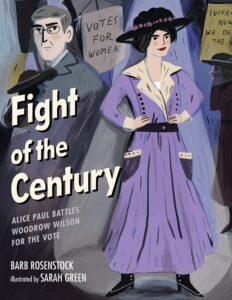
Fight of the Century: Alice Paul Battles Woodrow Wilson for the Vote
By Barb Rosenstock, Illustrated by Sarah Green
When Woodrow Wilson was elected President, he didn’t know that he would be participating in one of the greatest fights of the century: the battle for women’s right to vote. The formidable Alice Paul led the women’s suffrage movement and saw President Wilson’s election as an opportunity to win the vote for women. She battered her opponent with endless strategic arguments and carefully coordinated protests, calling for a new amendment to grant women the right to vote.
With a spirit and determination that never quit, even when peaceful protests were met with violence and even when many women were thrown in jail, Paul eventually convinced President Wilson to support her cause, changing the country forever. Framed as a boxing match, this book provides a fascinating and compelling look at an important moment in American history. Grades 2-5

The Voice that Won the Vote: How One Woman’s Words Made History
By Elisa Boxer, Illustrated by Vivien Mildenberger
In August of 1920, women’s suffrage in America came down to the vote in Tennessee. If the Tennessee legislature approved the 19th amendment it would be ratified giving all American women the right to vote. The historic moment came down to a single vote. The voter who tipped the scale toward equality did so because of a powerful letter from his mother. Febb Burn urged her son Harry to “Vote for suffrage and don’t forget to be a good boy.” The Voice That Won the Vote is the story of Febb, Harry, and the letter than gave all American women a voice. Grades 2-5
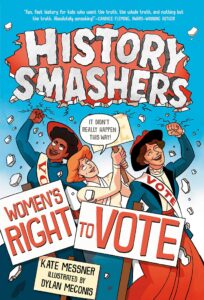
History Smashers: Women’s Right to Vote
By Kate Messner, Illustrated by Dylan Meconis
In 1920, Susan B. Anthony passed a law that gave voting rights to women in the United States. RIGHT?
WRONG! Susan B. Anthony wasn’t even alive when the Nineteenth Amendment was ratified. Plus, it takes a lot more than one person to amend the constitution.
The truth is, it took millions of women to get that amendment into law. They marched! They picketed! They even went to jail. But in the end, it all came down to a letter from a state representative’s mom. No joke.
Through illustrations, graphic panels, photographs, sidebars, and more, Kate Messner smashes history by exploring the little-known details behind the fight for women’s suffrage. Grades 3-7
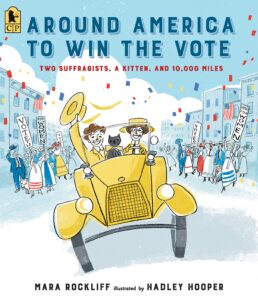
Around America to Win the Vote:
Two Suffragists, a Kitten, and 10,000 Miles
By Mara Rockliff, Illustrated by Hadley Hooper
In April 1916, Nell Richardson and Alice Burke set out from New York City in a little yellow car, embarking on a bumpy, muddy, unmapped journey ten thousand miles long. They took with them a teeny typewriter, a tiny sewing machine, a wee black kitten, and a message for Americans all across the country: Votes for Women!
The women’s suffrage movement was in full swing, and Nell and Alice would not let anything keep them from spreading the word about equal voting rights for women. Braving blizzards, deserts, and naysayers—not to mention a whole lot of tires stuck in the mud—the two courageous friends made their way through the cities and towns of America to further their cause. Grades K-3
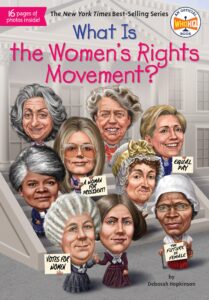
What Is the Women’s Right to Vote?
By Deborah Hopkinson, Illustrated by Laurie A. Conley
From Susan B. Anthony and Elizabeth Cady Stanton to Gloria Steinem and Hillary Clinton, women throughout US history have fought for equality. In the nineteenth and early twentieth centuries, women were demanding the right to vote. During the 1960s, equal rights and opportunities for women–both at home and in the workplace–were pushed even further. And in the more recent past, Women’s Marches have taken place across the world. Celebrate how far women have come with this inspiring read! 8-12 years

Miss Paul and the President:
The Creative Campaign for Women’s Right to Vote
By Dean Robbins, Illustrated by Nancy Zhang
When Alice Paul was a child, she saw her father go off to vote while her mother had to stay home. But why should that be? So Alice studied the Constitution and knew that the laws needed to change. But who would change them?
She would! In her signature purple hat, Alice organized parades, wrote letters and protested outside the White House. She even met with President Woodrow Wilson, who told her there were more important issues to worry about than women voting. But nothing was more important to Alice. So she kept at it, and soon President Wilson was persuaded. This unsung hero will show young voters-to-be how important it is to never back down from a cause you believe in. Preschool – Grade 3

Elizabeth Started All the Trouble
By Doreen Rappaport, Illustrated by Matt Faulkner
She couldn’t go to college.
She couldn’t become a politician.
She couldn’t even vote.
But Elizabeth Cady Stanton didn’t let that stop her.
She called on women across the nation to stand together and demand to be treated as equal to men – and that included the right to vote. It took nearly seventy-five years and generations of women fighting for their rights through words, through action, and through pure determination . . . for things to slowly begin to change.
With the help of these trailblazers’ own words, Doreen Rappaport shows readers just how far this revolution has come, and inspires them to keep it going! Preschool – Grade 3
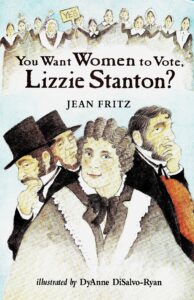
You Want Women to Vote Lizzie Stanton?
By Jean Fritz, Illustrated by Dyane DiSalvo Ryan
This biography of Elizabeth Cady Stanton is as spirited as the women’s rights pioneer herself.
Who says women shouldn’t speak in public? And why can’t they vote? These are questions Elizabeth Cady Stanton grew up asking herself. Her father believed that girls didn’t count as much as boys, and her own husband once got so embarrassed when she spoke at a convention that he left town.
Luckily Lizzie wasn’t one to let society stop her from fighting for equality for everyone. And though she didn’t live long enough to see women get to vote, our entire country benefited from her fight for women’s rights. Grades 3-7
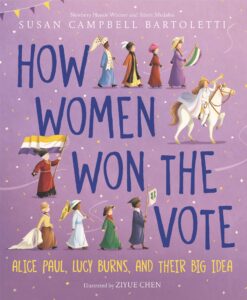
How Women Won the Right to Vote:
Alice Paul, Lucy Burns, and Their Big Idea
By Susan Campbell Bartoletti, Illustrated by Ziyue Chen
From Newbery Honor medalist Susan Campbell Bartoletti in time to celebrate the 100th anniversary of women’s suffrage in America comes the story of the little-known DC Women’s March of 1913.
Bartoletti introduces readers to suffragists Alice Paul and Lucy Burns. They met in a London jail and fought their way through hunger strikes, jail time, and much more to win a long, difficult victory for America and its women.
Includes extensive back matter and dozens of archival images to evoke the time period between 1909 and 1920. Grades 3-7
The book descriptions used in this post are primarily from the publishers.
If you like this post, then please consider sharing it and/or leaving a comment below. Thank you! Barbara Lowell, Children’s Author
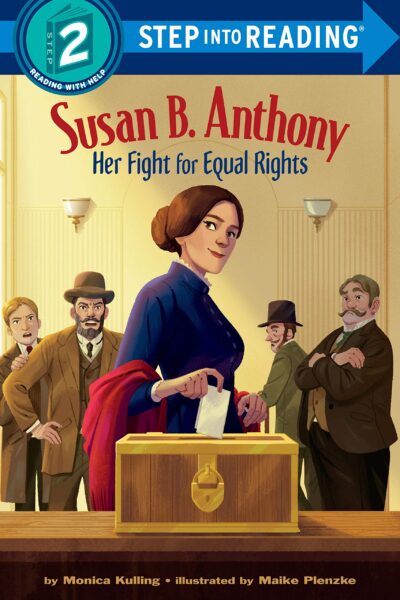
Susan B. Anthony: Her Fight for Equal Rights
By Monica Kulling, Illustrated by Maike Plenzke
“It’s not fair.” Susan B. Anthony was very concerned about fairness and equality for women and girls in America. She knew it wasn’t fair to pay a woman less than a man for the same job. She knew it wasn’t fair not to allow women to vote in elections. In fact, it was illegal for women to vote. But she felt so strongly, she voted in an election–and was arrested–anyway.
Young readers will learn about young Susan B. Anthony and how she grew up to become a suffragette–a fighter for women’s equality. She joined forces with Elizabeth Cady Stanton and others and gave speeches around the country to gain support for women’s right to vote. She fought her whole life, and believed that “failure is impossible.” She was right; her work made the 19th Amendment to the Constitution possible!
Step 3 Readers feature engaging characters in easy-to-follow plots about popular topics–for children who are ready to read on their own. 4-6 years.

Susan B. Anthony
By Alexandra Wallner
During Susan B. Anthony’s life, women and men were not considered equal. Women could not own property or vote; nor could they receive good educations. But Susan envisioned a time when women would be treated fairly and so she became a voice for change.
Her speeches and articles about women’s suffrage made her unpopular–people threw rotten eggs at her and even threatened her life–yet she did not give up. In clear and simple words and jewel-like paintings, here is the essential story of the woman whose passion for justice led to the passing of the Nineteenth Amendment, which gave women the right to vote. 6-9 years
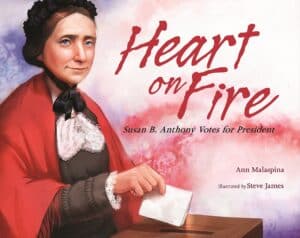
Heart on Fire: Susan B. Anthony Votes For President
By Ann Malaspina, Illustrated by Steve James
On November 5, 1872, Susan B. Anthony made history–and broke the law–when she voted in the U.S. presidential election, a privilege that had been reserved for men. She was arrested, tried, and found guilty: “The greatest outrage History every witnessed,” she wrote in her journal. It wasn’t until 1920 that women were granted the right to vote, but the civil rights victory would not have been possible without Susan B. Anthony’s leadership and passion to stand up for what was right. 4-8 years

Who Was Susan B. Anthony?
By Pam Pollack and Meg Belviso, Illustrated by Mike Lacey
Susan B. Anthony may be an international icon but her campaign for women’s rights had personal roots. Working as a school teacher in New York, Anthony refused to settle for less pay than her male colleagues which ignited her lifelong devotion to women’s equality. Anthony toured the United States and Europe giving speeches and publishing articles as one of the most important advocates of women’s rights. Learn more about the woman behind the movement.8-12 years

Susan B. Anthony: Fighter for Women’s Rights
By Deborah Hopkinson, Illustrated by Amy June Bates
Unlike most girls of her time, Susan B. Anthony received an education. And besides reading and writing, her schooling taught her that women should have the same rights as men, above all the right to vote. So from the time she was a young woman until the day she died, Susan worked very hard to change America and make her dream reality. 6-8 years
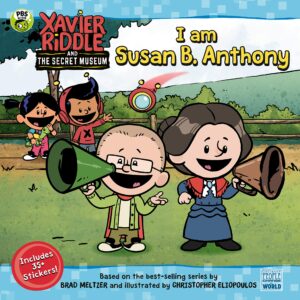
I Am Susan B. Anthony
By Nancy Parent
Brad feels left out when Xavier and Yadina take a vote without him. Thanks to Susan B. Anthony, they learn that everyone should have a vote! This episode-based 8×8 will focus on the traits that made our heroes great–the traits that kids can aspire to in order to live heroically themselves. 3-5 years
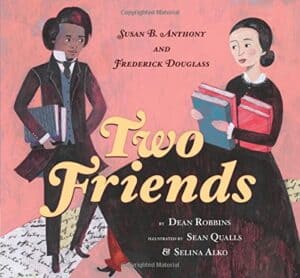
Two Friends: Susan B. Anthony and Frederick Douglass
By Dean Robbins, Illustrated by Sean Qualls and Selina Alko
Some people had rights, while others had none.
Why shouldn’t they have them, too?
Two friends, Susan B. Anthony and Frederick Douglass, get together for tea and conversation. They recount their similar stories fighting to win rights for women and African Americans. The premise of this particular exchange between the two is based on a statue in their hometown of Rochester, New York, which shows the two friends having tea. 4-8 years

Why Couldn’t Susan B. Anthony Vote?
And Other Questions About Women’s Suffrage
By Mary Kay Carson
Who was Susan B. Anthony—what did she stand for, why was she arrested, and how did she fight for women’s right to vote? And did she ever see her dream of woman’s suffrage come true? From the first women’s rights convention at Seneca Falls, New York, to the enactment of the 19th Amendment, this lively chronicle introduces Anthony and the American suffragist movement. 7 and up

Susan B. Anthony: Champion for Voting Rights
By Mark Shulman, Illustrated by Kelly Tindall
This is a biography of the woman who was at the forefront of the women’s suffrage movement in the late nineteenth and early twentieth centuries. Along with other social reformers such as Elizabeth Cady Stanton and Frederick Douglass, Anthony not only paved the way for women seeking the right to vote but also spoke out against the institution of slavery, at great personal risk. Full-color illustrations and historically accurate text make this biography an entertaining, educational, and inspiring read for those who enjoy history and graphic novels. 8-12 years
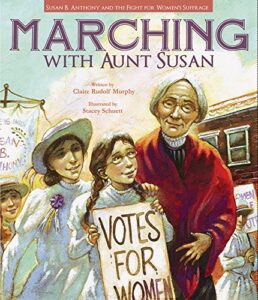
Marching With Aunt Susan
By Claire Rudolf Murphy, Illustrated by Stacy Schuett
This is the inspiring story of the fight for women’s suffrage, based on the experiences of a real girl. All Bessie wants is to go hiking with her father and brothers. But it’s 1896, and girls don’t get to hike. They can’t vote either, which Bessie discovers when Susan B. Anthony comes to town to help lead the campaign for women’s suffrage. Stirred to action, Bessie joins the movement and discovers that small efforts can result in small changes―and maybe even big ones.
Inspired by the diary of the real Bessie Keith Pond, a ten-year-old girl who lived in California during the suffrage campaign, this story offers a thought-provoking introduction to the fight for women’s rights. A story of hope and determination, Marching with Aunt Susan reminds readers that society cannot evolve unless people―even young people―dare to take a stand. 6-10 years
The book descriptions used are primarily from the publishers.
If you like this post, then please consider sharing it and/or leaving a comment below. Thank you! Barbara Lowell, Children’s Author
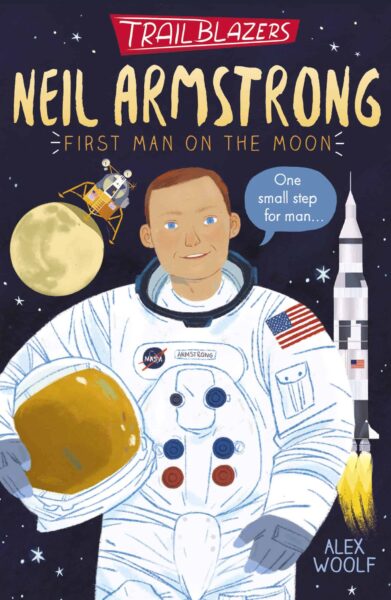
Trailblazers: Neil Armstrong
By Alex Woolf
Neil Armstrong become the first person to set foot on the moon. Long before that astonishing day in 1969, Armstrong was already dreaming of journeys above the clouds, visiting air shows and gaining his student pilot’s license at age sixteen. Find out how this flight-obsessed astronaut went on to take one of the most momentous steps in history. 8-10 years
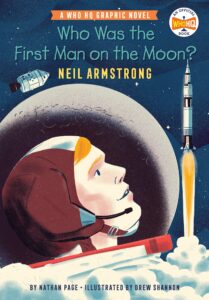
Who Was the First Man on the Moon? Graphic Novel
By Nathan Page, Illustrated by Drew Shannon
From his childhood experiments to his first encounters with flight, explore the steps Neil Armstrong took in order to become the first person to land on the moon. A story of calculated risk, perseverance, and earth-defying reward, this graphic novel invites readers to immerse themselves in the life of the famous astronaut — brought to life by gripping narrative and full-color illustrations that fly off the page. 8-12 years

When Neil Armstrong Built a Wind Tunnel
by Mark Andrew Weakland, Illustrated by Luciano Lozano
Astronaut Neil Armstrong couldn’t be held down by Earth’s gravity. As the first person to step foot on the moon, Neil took the U.S. space program to new heights. But before that, he had a humble boyhood of cutting lawns, cleaning ovens, washing airplanes and plenty of adventures, including building a wind tunnel in his parents’ basement! This playful story shows young readers that the sky’s not the limit for their own dreams. 6-8 years
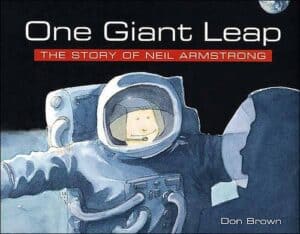
One Giant Leap: The Story of Neil Armstrong
By Don Brown
As a young boy, Neil Armstrong had a recurring dream in which he held his breath and floated high above the people, houses, and cars. He spent his free time reading stacks of flying magazines, building model airplanes, and staring through his homemade telescope mounted on the roof of his neighbor’s garage. As a teenager, Neil became obsessed with the idea of flight, working odd jobs to pay for flying lessons at a nearby airport. He earned his student pilot’s license on his sixteenth birthday.
Who knew that this shy boy, who also loved books and music, would become the first person to set foot on the moon. This is the inspiring story of one boy’s dream – a dream of flying that landed him more than 200,000 miles away from his home on earth. 4-7 years
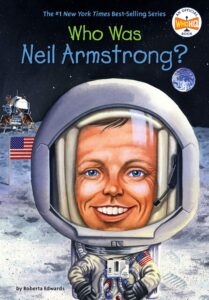
Who Was Neil Armstrong?
By Roberta Edwards
On July 20, 1969, Neil Armstrong stepped on the moon and to an audience of over 450 million people, proclaimed his step a “giant leap for mankind.” This Eagle Scout built his own model planes and grew up to become first a test pilot for experimental aircraft and then an astronaut, the first to walk on the moon. Over 80 black-and-white illustrations bring Armstrong’s story to life. 8-12 years
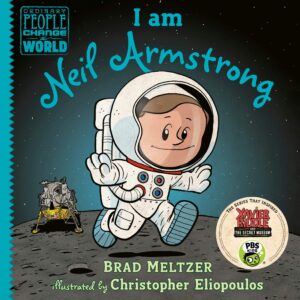
I am Neil Armstrong
By Brad Meltzer, Illustrated by Christopher Eliopoulos
This fun biography focuses on the traits that made Neil Armstrong, the first man to walk on the moon, great — traits that kids can aspire to. I am Neil Armstrong tells the story of one of America’s icons in a lively, conversational way that works well for the youngest nonfiction readers and that includes his childhood influences. At the back is a timeline and photos. 5-8 years
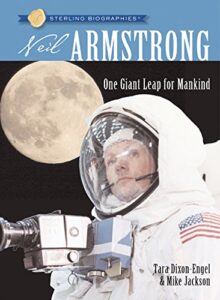
Neil Armstrong One Giant Leap for Mankind
By Tara Dixon-Engel Illustrated by Mike Jackson
Neil Armstrong was America’s rocket man, the first person to set foot on the moon and turn science fiction into amazing reality. Award-winning authors Tara Dixon-Engel and Mike Jackson tell the fascinating story of how Armstrong went where no one had gone before, leaving his mark on the powdery surface of another world.
Even at an age when other boys were just learning to drive, Neil was training to reach the skies. He went on to study aeronautical engineering, win medals as a fighter pilot, try out the X-15 experimental rocket plane, and become one of the elite few chosen to be a NASA astronaut…where he took the test pilot’s credo of “higher, faster and farther” to thrilling heights. 10 and up

Pocket Bios: Neil Armstrong
By Al Berenger
Neil Armstrong is an American astronaut most famous for being the first person to walk on the moon: “One small step for man, one giant leap for mankind.” Before enrolling in the NASA Astronaut Corps in 1962, Armstrong was an officer in the U.S. Navy and served in the Korean War. Follow this extraordinary man’s life and accomplishments, from childhood to space and back again. 4-7 years
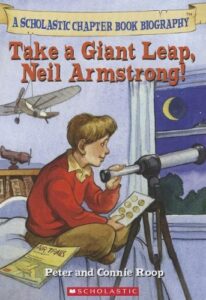
Take a Giant Leap Neil Armstrong
By Peter and Connie Roop
This Scholastic Chapter Book is a biography of Neil Armstrong, the first man on the moon and tells what he was like as a young boy.
The book descriptions used are primarily from the publisher.
If you like this post, then please consider sharing it and/or leaving a comment below. Thank you! Barbara Lowell, Children’s Author
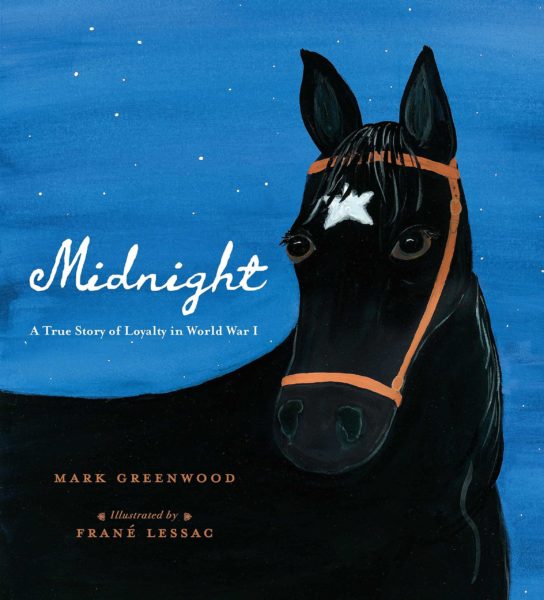
Midnight: A True Story of Loyalty in World War I
By Mark Greenwood, Illustrated By Frané Lessac
Guy Haydon raised and trained Midnight from the time she was a foal. The two had such a strong bond that when World War I broke out, Lieutenant Haydon slipped away from the frontlines of Gallipoli on an Egypt-bound ship to reunite with his horse. There, in the city of Beersheba, on October 31, 1917, two regiments of the Australian Light Horse Brigade took part in one of the last great cavalry charges in history. Among the first to leap the enemy trenches was Lieutenant Guy Haydon, riding Midnight—who succumbed to a bullet that might have otherwise killed her rider. In a new story from an award-winning duo, luminous illustrations and lyrical narration bring a sad moment in history to life. 5-9 years

Winnie’s Great War
by Lindsay Mattick and Josh Greenhut, Illustrated by Sophie Blackall
Here is a heartwarming imagining of the real journey undertaken by the extraordinary bear who inspired Winnie-the-Pooh. From her early days with her mama in the Canadian forest, to her remarkable travels with the Veterinary Corps across the country and overseas, and all the way to the London Zoo where she met Christopher Robin Milne (and inspired the creation of the world’s most famous bear,) Winnie is on a great war adventure.
This story is a blending of deep research and magnificent imagination. Infused with Sophie Blackall’s renderings of an endearing bear, the book is also woven through with entries from Captain Harry Colebourn’s real wartime diaries and contains a selection of artifacts from the Colebourn Family Archives. The result is a one-of-a-kind exploration into the realities of war, the meaning of courage, and the indelible power of friendship, all told through the historic adventures of one extraordinary bear. 8-11 years
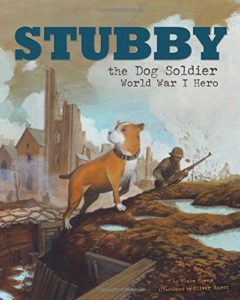
Stubby The Dog Soldier: World War I Hero
By Blake Hoena, Illustrated by Oliver Ian Hurst
A stray dog named Stubby braves the World War I battlefields alongside Private J. Robert Conroy. See the story unfold as this brave little canine makes a big difference in the lives of many World War I soldiers. 5-7 years
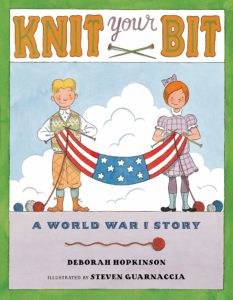
Knit Your Bit! A World War I Story
By Deborah Hopkinson, Illustrated by Steven Guarnaccia
Mikey’s dad has left home to fight overseas during World War I, and Mikey wants to do something BIG to help. When his teacher suggests that the class participate in a knitting bee in Central Park to knit clothing for the troops, Mikey and his friends roll their eyes—knitting is for girls! But when the girls turn it into a competition, the boys just have to meet the challenge.
Based on a real “Knit-In” event at Central Park in 1918, Knit Your Bit shows readers that making a lasting contribution is as easy as trying something new! 5-8 years
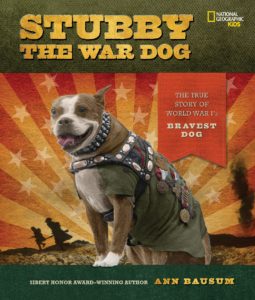
Stubby the War Dog: The True Story of World War I’s Most Famous Dog
By Ann Bausum
Move over, Rin Tin Tin. Here comes Sgt. Stubby! That German shepherd, Rin Tin Tin, star of the silver screen may have been born behind enemy lines during World War I, but Stubby, the stump-tailed terrier, worked behind enemy lines, and gained military honors along the way.
Private Robert Conroy casually adopted the orphan pup while attending basic training on the campus of Yale University in 1917. The Connecticut volunteer never imagined that his stray dog would become a war hero. He just liked the little guy. When Conroy’s unit shipped out for France, he smuggled his new friend aboard. By the time Stubby encountered Conroy’s commanding officer, the dog had perfected his right-paw salute. Charmed, the CO awarded Stubby mascot status and sent him along with Conroy’s unit to the Western Front. 10-13 years
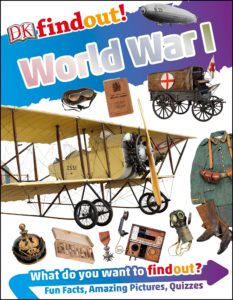
DK Findout! World War I
By Brian Williams
Did you know that the Allied powers used 33,000 camels in desert warfare? Or that more than 500,000 pigeons carried messages to the war’s front lines? Find out why!
Perfect for young history buffs and fans of the Axis & Allies board games, DK findout! World War I is a highly visual world-history book sure to inspire the next amazing school project or report. Inside, author Brian Williams breaks down why the war began, how it was fought, and what brought it to an end. 6-9 years
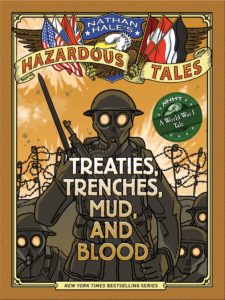
Treaties, Trenches, Mud, and Blood
By Nathan Hale
World War I set the tone for the 20th century and introduced a new type of warfare: global, mechanical, and brutal. Nathan Hale has gathered some of the most fascinating true-life tales from the war and given them his inimitable Hazardous Tales twist. Easy to understand, funny, informative, and lively, this series is the best way to be introduced to some of the most well-known battles (and little-known secrets) of the infamous war. 8-12

Dazzle Ships: World War I and the Art of Confusion
By Chris Barton, Illustrated by Victo Ngai
During World War I, British and American ships were painted with bold colors and crazy patterns from bow to stern. Why would anyone put such eye-catching designs on ships?
Desperate to protect ships from German torpedo attacks, British lieutenant-commander Norman Wilkinson proposed what became known as dazzle. These stunning patterns and colors were meant to confuse the enemy about a ship’s speed and direction. By the end of the war, more than four thousand ships had been painted with these mesmerizing designs.
Author Chris Barton and illustrator Victo Ngai bring to life this little-known story of how the unlikely and the improbable became just plain dazzling. 7-11 years

Where Poppies Grow: A World War I Companion
By Linda Granfield
When World War I began in 1914, no one knew that millions of young people would die in the agonizing years ahead. No one imagined the effect it would have on family life, or that whole villages would disappear, or that entire nations would be changed forever. They believed their sons and daughters, mothers and fathers would be home by Christmas. They were tragically mistaken.
With photos, memorabilia, and anecdotes, Linda Granfield brings us face-to-face with people from all walks of life who risked everything for their country. These painstakingly-gathered bits and pieces are remnants of conflict on a scale never before witnessed. Hastily-penned letters, notes written in code, and prayers for deliverance form an eloquent portrait of humanity, and a startling comment on the devastation of war. 11 and up

World War I For Kids: A History with 21 Activities
By R. Kent Rasmussen
One hundred years after the start of the “Great War,” World War I for Kids provides an intriguing and comprehensive look at this defining conflict that involved all of the world’s superpowers. Why and how did the war come about? What was daily life like for soldiers in the trenches? What roles did zeppelins, barbed wire, and the passenger ship Lusitania play in the war? Who were Kaiser Wilhelm, the Red Baron, and Edith Cavell? Young history buffs will learn the answers these questions and many others, including why the western front bogged down into a long stalemate; how the war ushered in an era of rapid military, technological, and societal advances; and how the United States’ entry helped end the war.
Far from a dry catalog of names, dates, and battles, this richly illustrated book goes in depth into such fascinating topics as turn-of-the-20th-century weaponry and the important roles animals played in the war, and explains connections among events and how the war changed the course of history. Hands-on activities illuminate both the war and the times.
Kids can: Make a periscope, teach a dog to carry messages, make a parachute, learn a popular World War I song, cook Maconochie Stew and much more. 9 and up
The book descriptions used are primarily from the publishers.
If you like this post, then please consider sharing it and/or leaving a comment below. Thank you! Barbara Lowell, Children’s Author!

Who Were the Wright Brothers?
By James Buckley, Jr., Illustrated by Tim Foley
As young boys, Orville and Wilbur Wright loved all things mechanical. As young men, they gained invaluable skills essential for their success. They worked with printing presses, bicycles, motors, and any sort of machinery they could get their hands on. As adults, the brothers worked together to invent, build, and fly the world’s first successful airplane. This is the story of the two inventors and aviation pioneers who never lost sight of their dream: to fly, and to soar higher!

Science Comics: Flying Machines: How the Wright Brothers Soared
Benjamin A. Wilgus, Illustrated by Molly Brooks
Follow the famous aviators from their bicycle shop in Dayton, Ohio, to the fields of North Carolina where they were to make their famous flights. In an era of dirigibles and hot air balloons, the Wright Brothers were among the first innovators of heavier than air flight.
But in the hotly competitive international race toward flight, Orville and Wilbur were up against a lot more than bad weather. Mechanical failures, lack of information, and even other aviators complicated the Wright Brothers’ journey. Though they weren’t as wealthy as their European counterparts, their impressive achievements demanded attention on the international stage. Thanks to their carefully recorded experiments and a healthy dash of bravery, the Wright Brothers’ flying machines took off. 9-13 years
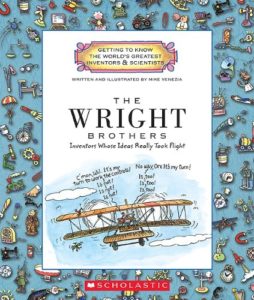
Wright Brothers: Inventors Whose Ideas Really Took Flight
By Mike Venezia
Meet the Wright Brothers! Getting to Know the World’s Greatest Inventors and Scientists series combines a mix of full-color historical reproductions, photos, and cartoon-style illustrations. These bring to life the work and contributions of renowned scientists and inventors.

The Wright Sister: Katharine Wright and her Famous Brothers
By Richard Maurer
Not many people know that the Wright brothers had a sister, Katharine Wright. She supported her high-flying, inventor brothers through their aviation triumphs and struggles. This is her story.
On a chilly December day in 1903, a young woman came home from her teaching job in Dayton, Ohio, to find a telegram waiting for her. The woman was Katharine Wright. The telegram, from her brother Orville, announced the first successful airplane flight in history. Richard Maurer tells Katharine’s story. Smart and well-educated, she was both confidant and caregiver to her bachelor brothers. She managed many of their affairs, traveling with them on frequent trips to demonstrate and promote their invention. She cared for them when they were sick from disease and injury. In doing so, she gave up her ambitions as a teacher and her early hopes of marriage.
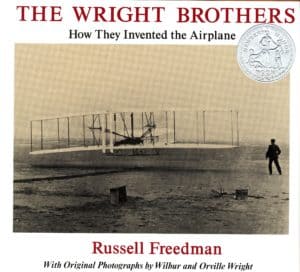
The Wright Brothers: How They Invented the Airplane
By Russell Freedman
This is a narrative account of Orville and Wilbur Wright’s story. They had little formal schooling but a knack for solving problems. The book chronicles their lives from their early mechanical work on toys and bicycles through the development of several flyers. The Wright Brothers follows the siblings through their achievements—not only the first powered, sustained, controlled airplane flight, but the numerous improvements and enhancements.
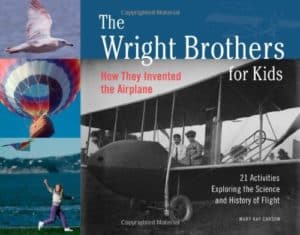
The Wright Brothers For Kids: They Invented the Airplane, 21 Activities Exploring Science and the History of Flight
By Mary Kay Carson
This activity book tells the true story of how two bicycle-making brothers from Ohio, with no more than high-school educations, accomplished a feat that forever changed the world. At a time when most people still hadn’t ridden in an automobile, Wilbur and Orville Wright built the first powered, heavier-than-air flying machine.
Woven throughout the story of the two brothers are activities that highlight their ingenuity and problem-solving abilities as they overcame many obstacles to achieve controlled flight.
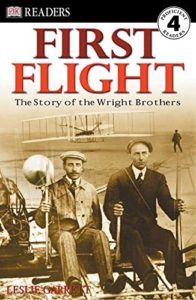
First Flight: The Wright Brothers DK Reader
By Leslie Garrett
In this DK Level 4 Reader, follow the story of brothers Wilbur and Orville Wright as they plan and build a flying machine!
Photographs combine with illustrations and age-appropriate stories to capture a child’s interest while developing their reading skills and general knowledge.
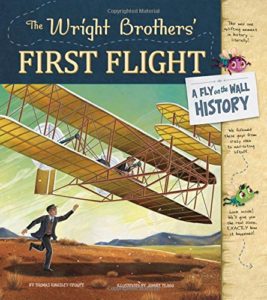
The Wright Brothers First Flight: A Fly on the Wall History
By Thomas Kingsley Troupe, Illustrated by Jomike Tejido
From a sandy North Carolina dune to mid air … Two cartoon flies join readers as they follow Orville and Wilbur Wright on their quest for flight. This book provides a blend of facts and fun while telling the story of a great moment in American and aviation history.

My Brother’s Flying Machine: Wilbur, Orville and Me
By Jane Yolen, Illustrated by Jim Burke
In celebration of the Wright Brothers’ flight, this story is told from the point of view of their sister, Katharine, who watched her brothers play with a toy flying machine, which was the beginning of their remarkable collaboration.
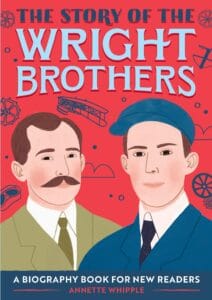
The Story of the Wright Brothers
By Annette Whipple
The Wright brothers were the first people ever to build and fly an airplane, doing what many people at the time didn’t think was possible. Before they made history with their airplane, Wilbur and Orville were curious kids who loved learning about the world around them and how it worked. They fell in love with the idea of flying and taught themselves everything they needed to know to make their dream come true.
Explore how the Wright brothers went from young boys growing up in Ohio to world-famous inventors, aviators, and businessmen. How will their hard work and big imaginations inspire you?
The Story of the Wright Brothers includes:
Lasting change―Learn about how the Wright brothers’ inventions changed how we live today.
Helpful glossary―Find definitions for some of the more advanced words and ideas in the book.
Visual timeline―Watch the Wright brothers progress from curious kids to famous flyers.
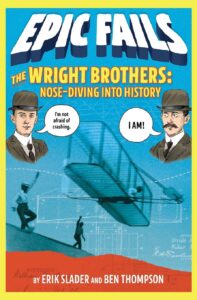
The Wright Brothers: Nose Diving into History
By Ben Thompson
A hilarious nonfiction look at two of history’s most epic “failures”: the Wright brothers, whose countless crashes ultimately led to groundbreaking success.
Although Orville and Wilbur Wright are celebrated today as heroes for their revolutionary contributions to science and engineering―they are acknowledged as the first men to successfully achieve powered, piloted flight―their success was hard-earned. (Spoiler alert: there were a lot of nosedives involved.) In fact, it took the self-taught engineers years of work and dozens of crashes before they managed a single twelve-second flight!
The book descriptions used are primarily from the publishers.
If you like this post, then please consider sharing it and/or leaving a comment below. Thank you! Barbara Lowell, Children’s Author

Electrical Wizard: How Nikola Tesla Lit Up the World
By Elizabeth Rusch, Illustrated by Oliver Dominguez
Here is the story of the ambitious young man who brought life-changing ideas to America, despite the obstructive efforts of his hero-turned-rival, Thomas Edison. From using alternating current to light up the Chicago World’s Fair to harnessing Niagara Falls to electrify New York City and beyond, Nikola Tesla was a revolutionary ahead of his time. Elizabeth Rusch sheds light on this extraordinary figure, while fine artist Oliver Dominguez brings his life and inventions to vivid color. Back matter includes additional information about Tesla, scientific notes and explanations, source notes, a bibliography, and suggestions for further reading. 8-12 years
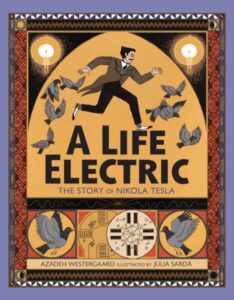
A Life Electric: The Story of Nikola Tesla
By Azadeh Westergaard, Illustrated by Júlia Sardà
Born at the stroke of midnight during a lightning storm, Nikola Tesla grew up to become one of the most important electrical inventors in the world. But before working with electricity, he was a child who loved playing with the animals on his family’s farm in Serbia.
An inventor since childhood, Tesla’s patents encompassed everything from radar and remote-control technology to wireless communications. But his greatest invention was the AC induction motor, which used alternating currents ( AC) to distribute electricity and which remains the standard for electric distribution today. Tesla’s love of animals also remained constant throughout his life and led to his anointment as the Pigeon Charmer of New York for his devotion to nature’s original wireless messengers. 5-9 years
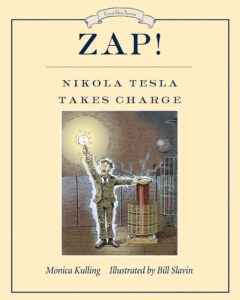
Zap! Nikola Tesla Takes the Charge
By Monica Kulling, Illustrated by Bill Slavin
Growing up in Smiljan, Croatia, Nikola Tesla dreamed about harnessing the power of Niagara Falls. In 1884, he walked down the gangplank onto New York Harbor with four cents in his pocket, a book of poems, a drawing of a flying machine, and a letter of introduction to Thomas Edison, the “electrical wizard” of America. Upon meeting, Edison sent Tesla to fix the SS Oregon as a test and was so astounded that he offered Tesla a job at his factory.
Tesla and Edison had different views about electricity. Tesla wanted to develop an alternate current while Edison wanted to stick to the direct current system. Edison offered Tesla a large sum to make his direct current system more efficient, but when the work was done, Edison refused to pay. Tesla quit and when things were looking bleak, he met George Westinghouse, who also thought that alternating current was the way to light up America. He gave Tesla a job and in 1896, Tesla and Westinghouse built a generator at Niagara Falls that was able to send power as far as Buffalo, New York. 5-8 years
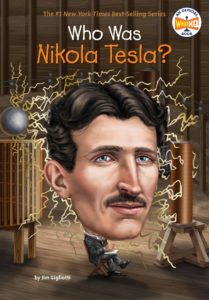
Who Was Nikola Tesla?
By Jim Giglotti, Illustrated by John Hinderliter
When Nikola Tesla arrived in the United States in 1884, he didn’t have much money, but he did have a letter of introduction to renowned inventor Thomas Edison. The working relationship between the two men was short lived. The two scientist-inventors became harsh competitors. One of the most influential scientists of all time, Nikola Tesla is celebrated for his experiments in electricity, X-rays, remote controls, and wireless communications. His invention of the Tesla coil was instrumental in the development of radio technology. 8-12 years

Bright Dreams: The Brilliant Ideas of Nikola Tesla
By Tracy Dockray
Young Nikola Tesla got a shock when he rubbed his cat’s fur. That small spark lit his imagination forever. Covering his early years to his eventual success in the world of electricity, Bright Dreams showcases Tesla’s incredible journey of discovery and perseverance. Author-illustrator Tracy Dockray conveys Tesla’s busy and imaginative world with collage-style artwork and informative sidebars. 8-11 years
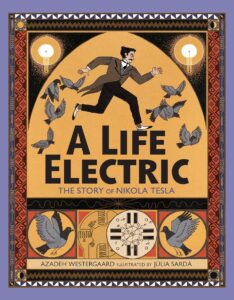
A Life Electric: The Story of Nikola Tesla
By Azadeh Westergaard, Illustrated by Júlia Sardá
Born at the stroke of midnight during a lightning storm, Nikola Tesla grew up to become one of the most important electrical inventors in the world. But before working with electricity, he was a child who loved playing with the animals on his family’s farm in Serbia.
An inventor since childhood, Tesla’s patents encompassed everything from radar and remote-control technology to wireless communications. But his greatest invention was the AC induction motor, which used alternating currents ( AC) to distribute electricity and which remains the standard for electric distribution today. Tesla’s love of animals also remained constant throughout his life and led to his anointment as the Pigeon Charmer of New York for his devotion to nature’s original wireless messengers. 5-9 years Forthcoming July 2021

Nikola Tesla For Kids: His Life, Ideas and Inventions
with 21 Activities
By Amy M. O’Quinn
Nikola Tesla was a physicist, scientist, electrical engineer, and world-renowned inventor whose accomplishments faded into oblivion after his death in 1943. Tesla was undeniably eccentric and compulsive; some considered him to be somewhat of a “mad” scientist. But in reality, he was a visionary. Many of his ideas and inventions that were deemed impossible during his lifetime have since become reality.
He was the first to successfully use rotating magnetic fields to create an AC (alternating current) electrical power supply system and induction motor. He is now acknowledged to have invented the radio ahead of Marconi. Among other things, he developed the Tesla coil, an oscillator, generators, fluorescent tubes, neon lights, and a small remote-controlled boat. He helped design the world’s first hydroelectric plant at Niagara Falls. This is the story of his life and ideas, complete with a timeline, 21 hands-on activities, and additional resources to better understand his many accomplishments. 9 and up.
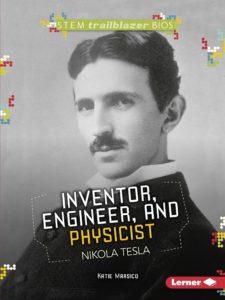
Inventor, Engineer, and Physicist Nikola Tesla
By Katie Marsico
Have you ever tried to invent something? As a child, Nikola Tesla saw a picture of a waterfall and imagined an invention that would turn the water’s energy into electricity. Later, he invented a waterwheel which turned water power into usable energy. As a young adult, Tesla spent his spare time experimenting with electrical equipment. He worked for inventor Thomas Edison, improving power plants and machines that ran on direct current electricity. But Tesla believed electrical distribution could be better. He went on to invent alternating current electricity, which would allow people to distribute electricity over long distances. Learn how Tesla’s work eventually made turning on electrical devices as easy as flipping a switch! 7-11 years
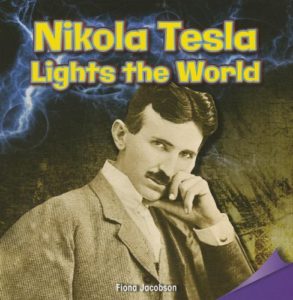
Nicola Tesla Lights the World
By Fiona Jacobson
Young readers will explore the life and work of Nikola Tesla, one the brightest inventors in history in this biography aligned to third grade Common Core Standards. 7-9 years
The book descriptions used are primarily from the publishers.
If you like this post, then please consider sharing it and/or leaving a comment below. Thank you! Barbara Lowell, Children’s Author
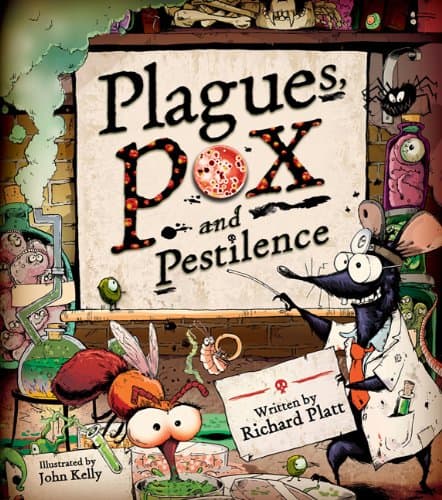
Plagues, Pox, and Pestilence
By Richard Platt , Illustrated by John Kelly
Plagues, Pox, and Pestilence is a history of disease, and pestilence, told from the point of view of the bugs and pests that cause them. This book features case histories of epidemics and eyewitness accounts from the rats, flies, ticks and creepy-crawlies who spread diseases. There are lots of fascinating facts and figures on the biggest and worst afflictions. 7-12 years

Outbreak! Plagues That Changed History
By Bryn Barnard
Filled with fascinating, often gory details about disease and history, Outbreak! is the combination of science and history.
Did the Black Death destroy medieval Europe? Did cholera pave the way for modern Manhattan? Did yellow fever help end the slave trade? Remarkably, the answer to all of these questions is yes. Time and again, diseases have impacted the course of human history in surprisingly powerful ways. Bryn Barnard describes the symptoms and paths of the world’s worst diseases—and how the epidemics they spawned have changed history forever. 8-12 years

Epidemic, Pandemic, Should I Call the Medic?
By Baby Professor
What is the difference between epidemics and pandemics? Learn the difference and more in this biology book for kids. 6 and up
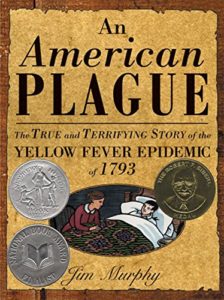
An American Plague:
The True and Terrifying Story of the Yellow Fever Epidemic of 1793
By Jim Murphy
In 1793, Philadelphia was the nation’s capital and the largest city in North America. It’s devastated by an apparently incurable disease, its cause unknown.
Jim Murphy describes the illness known as yellow fever. It took a toll on the city’s residents. He relates the epidemic to the major social and political events of the day and to 18th-century medical beliefs and practices. Drawing on first-hand accounts, he spotlights the heroic role of Philadelphia’s free blacks in combating the epidemic. And the Constitutional crisis that President Washington faced when he was forced to leave the city while escaping the deadly contagion. The search for the fever’s causes and cure, not found for more than a century afterward, provides a suspenseful counterpoint to this story of a city under siege. 10-12 years
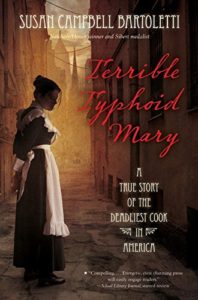
Terrible Typhoid Mary: A True Story of the Deadliest Cook in America
By Susan Campbell Bartoletti
What happens when a person’s reputation has been forever damaged? With archival photographs and text among other primary sources, this biography of Mary Mallon looks beyond the tabloid scandal of Mary’s controversial life. How she was treated by medical and legal officials reveals a lesser-known story of human and constitutional rights. It’s entangled with the science of pathology and the enduring questions about who Mary Mallon really was. How did her name become synonymous with deadly disease? And who is really responsible for the lasting legacy of Typhoid Mary? This exploration includes an author’s note, timeline, annotated source notes, and bibliography. 12 and up
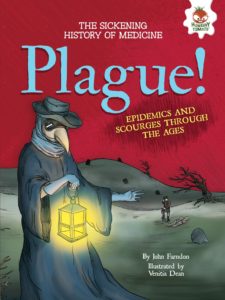
Plague! Epidemics, and Scourges Through the Ages
By John Farndon, Illustrated by Venitia Dean
Being sick is horrible. But it used to be worse. Inside this book, you’ll see evidence of the plagues of the past―rotting skin, dissolving lungs, and sinister swelling all over the body. Diseases like the Black Death wiped out whole towns and villages. Tuberculosis consumed young people like a bloodsucking vampire. And Smallpox left its victims scarred for life―if they survived. At the time, no one knew where these killer diseases came from or how to treat them. But eventually doctors discovered how these diseases and others were spread. Being sick isn’t quite as sickening as it was in the past! 8-12 years

Purple Death
By David Getz
The Spanish Flu was one of the worst epidemics in this country’s history, and the search for its cause is still one of science’s most urgent quests. David Getz tells young readers the story of the mysterious flu known as the Purple Death―the virus responsible for the worst epidemic in American history.
It was 1918, the last year of World War I. Thousands of men lived in crowded army training camps that were scattered all across the United States. That spring, a strange flu struck the soldiers at a camp in the Midwest. Healthy young men went to the hospital complaining of sore throats and fevers. Within hours they had suffocated, their skin taking on a terrible purplish hue.
The devastating flu spread like wildfire across the country, infecting soldiers and civilians alike. It killed more than half a million people in a matter of months, then disappeared as suddenly as it had come.
To this day, no one knows what caused a common flu to become so deadly, but scientists are still searching for answers. What they discover could save millions of lives if another common flu virus suddenly turns into a killer. 7-10 years

Fever 1793
By Laurie Halse Anderson
An epidemic of fever sweeps through the streets of Philadelphia.
During the summer of 1793, Mattie Cook lives above the family coffee shop with her widowed mother and grandfather. Mattie spends her days avoiding chores and making plans to turn the family business into the finest Philadelphia has ever seen. But then the fever breaks out.
The epidemic sweeps the streets, destroying everything in its path and turning Mattie’s world upside down. At her feverish mother’s insistence, Mattie flees the city with her grandfather. But she soon discovers that the sickness is everywhere, and Mattie must learn quickly how to survive in a city turned frantic with disease.
The book descriptions used are primarily from the publishers.
If you like this post, then please consider sharing it and/or leaving a comment below. Thank you! Barbara Lowell, Children’s Author
































































































